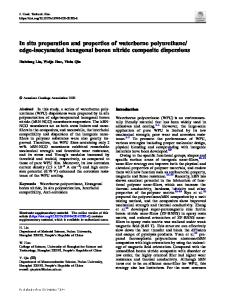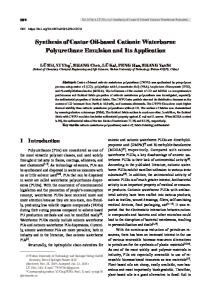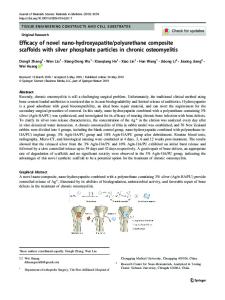Anticorrosive and UV-blocking waterborne polyurethane composite coating containing novel two-dimensional Ti3C2 MXene nan
- PDF / 3,059,561 Bytes
- 13 Pages / 595.276 x 790.866 pts Page_size
- 63 Downloads / 344 Views
Anticorrosive and UV-blocking waterborne polyurethane composite coating containing novel twodimensional Ti3C2 MXene nanosheets Xinxin Sheng1,*, Sihao Li1, Haowei Huang2, Yanfeng Zhao3, Ying Chen1, Li Zhang1, and Delong Xie4,* 1
Guangdong Provincial Key Laboratory of Functional Soft Condensed Matter, School of Materials and Energy, Guangdong University of Technology, Guangzhou 510006, China 2 School of Chemistry and Chemical Engineering, Guangdong Provincial Key Lab of Green Chemical Product Technology, South China University of Technology, Guangzhou 510640, China 3 School of Chemistry and Environment, South China Normal University, Guangzhou 510006, China 4 Yunnan Provincial Key Laboratory of Energy Saving in Phosphorus Chemical Engineering and New Phosphorus Materials, The Higher Educational Key Laboratory for Phosphorus Chemical Engineering of Yunnan Province, Faculty of Chemical Engineering, Kunming University of Science and Technology, Kunming 650500, China
Received: 19 July 2020
ABSTRACT
Accepted: 2 November 2020
In this work, Ti3C2 MXene, a novel two-dimensional nanosheet, was introduced to waterborne polyurethane (WPU) coatings to prepare a composite coating. First, MAX phase materials were in situ etched by HF acid and further intercalated by water molecules to obtain exfoliated single-layer MXene nanosheet. And then, composite coatings were prepared via solution-blending low addition (0–0.4 wt%) of MXene, self-prepared waterborne polyacrylate emulsion (PAE) and isocyanate hardener, applying on Q235 mild steel. Results of AFM, XRD SEM and SEM–EDS confirm that single-layer MXene nanosheets with large lateral-to-thickness ratio are successfully prepared and achieved homogenous distribution within WPU matrix. With 0.4 wt% MXene incorporated, the WPU/ Ti3C2 MXene composite coatings reach a lowest corrosion current of 2.143 9 10–6 A/cm2, a decrease of one order of magnitude compared with blank WPU (1.599 9 10–5 A/cm2) and own an excellent UV-blocking property (almost block the whole UV light).
Ó
Springer Science+Business
Media, LLC, part of Springer Nature 2020
Handling Editor: Maude Jimenez.
Address correspondence to E-mail: [email protected]; [email protected]
https://doi.org/10.1007/s10853-020-05525-2
J Mater Sci
GRAPHICAL ABSTRACT
Introduction Since its discovery, metallic materials with excellent ductility and plasticity have been producing great impact on industrial progress and human development [1, 2]. However, bare metals can corrode during long-term use in harsh environments such as moisture erosion, seawater scouring and rainwater soaking, which poses a potential and huge threat on human life [3, 4]. Therefore, before use, the metal surface should be undergone a series of anticorrosion treatments to prolong its service life. Various types anticorrosive strategies have been put forward, including inhibitors, chemical conversion coatings, polymeric coatings and cathodic protection [5–7]. Among them, applying polymeric coatings on the freshly polished metal surface is most conveni
Data Loading...











